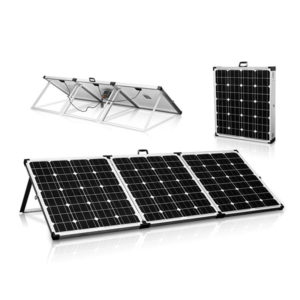
Faced with the imminent danger that global warming poses, Australia has started to switch to environment-friendly alternative energy to power almost everything. One of the cleanest forms of renewable energy is solar energy which can be harnessed by solar panels. An increasing number of households and businesses in the country are choosing to buy solar panels to fully replace their conventional power sources (i.e. fossil fuels).
Green Power: The Rise of Solar Panels for Sale

Green Power is a government program that encourages Aussies to replace their old energy sources with certified renewable energies such as solar panels. Formally launched more than two decades ago, the Green Power programme facilitates the installation of renewable energy generators and increases consumer awareness of the benefits of using green energy.
Households and businesses have the option to displace or replace their old energy source with renewable ones in percentages. For example, a household might choose to switch only 10% of their total energy consumption to green power. This is understandable, as the equipment required for a successful switch, like those solar panels for sale, can be costly.
When you buy solar panels to power either your household or business, you are helping the environment by reducing the country’s carbon footprint by as much as 18 million tonnes. Whilst it is true that the initial outlay can be costly, buying and installing solar panels can help reduce your overall energy consumption and costs, which will be reflected on your monthly energy bill.
Do’s and Don’ts of Buying Solar Panels
Not all solar panels are created equal. For those who have yet to switch to solar energy, buying solar panels can be a daunting task. Here is a basic consumer guide on how to choose the right solar panels for your home or business.
DO buy the complete solar panel system.
Most consumers tend to focus so much on solar panels that they sometimes forget it is not the only thing they should be buying. A complete solar panel system is composed of panels, inverter, and mounting.
It is easy to understand why people zero in on panels. After all, the solar panels are the most visible component in the system. However, the two other components (the inverter and mounting) are also equally important. The solar panel system will not work efficiently without the two other parts.
An inverter automatically converts the direct current (DC) power collected by the panels into usable 240V AC electricity. A good converter is likely to be worn out first before the panels, as they continuously work, which is why you need to be cautious or wary when purchasing one. There are two types of inverters: a micro-inverter and a string inverter. The difference between the two is that a string inverter is usually installed to convert energy collected by the whole solar panel system whilst a micro-inverter can only convert energy from a single solar panel.
The mounting, on the other hand, is where you securely attach the panels and roof supports. In absence of the mounting, the stability of the solar panel system would be compromised. It could also damage your roof.

DON’T be confused on choosing the type of solar panel.
Solar panels are made of either mono- or polycrystalline materials. Whilst both have a long list of pros and cons, it shouldn’t be a cause of panic or confusion. Just know that either material is tough enough to last for more than 25 years even under the harshest of Australian weather provided. Of course, you need to buy quality brands that offer long warranty.
DO find out how much solar energy you need.
Consumers have the option to choose how much power they want to get from solar energy. This will help you decide how much power your solar panel needs and how much solar rebate you can get. The solar rebate works like a discount, which is deducted from the total cost of installation. For example, buying and installing a 5kW solar system will give you a staggering $3,250 in rebates.
In addition, you’ll also be eligible to receive feed-in tariffs when you switch to solar energy. A feed-in tariff is the rate at which a consumer is paid for the solar electricity exported into the power grid. This means that if you can consume the maximum amount of solar energy possible, you’ll be able to get a much higher feed-in tariff. You’ll probably appreciate this incentive during summer when your air conditioning unit is working overtime.
DON’T mix solar panels.
The most common and biggest mistake of amateur installers is to assume that mixing solar panels is okay. After all, with solar panels all looking the same (regardless of the brand), what’s the worst that could happen?
Apparently, mixing solar panels can lead to a myriad of complications from performance degradation to permanent damage to your solar panel system. A solar panel system is a costly investment, so unintentionally damaging the panels by mixing them up can also spell disaster to your budget.
Solar panels, with the same current and voltage, should be purchased from the same manufacturer to make sure they are all compatible.
DO hire a professional to install your newly bought solar panel system.

Mounting and installing a solar panel system is not your average home renovation project. You also need to be knowledgeable on how to properly connect the panels with each other and the inverter for the system to work.
Despite some sellers claiming that you’ll get the most savings in doing the installation by yourself, this is not recommended especially if you have no experience on electric system. A wrong wiring or connection can be costly, if not risky.
DON’T be rash in purchasing solar batteries.
In principle, purchasing a battery to store any excess solar juice is a good advice, but solar batteries are expensive.
A single solar battery can cost as much as $10,000. Computing the possible return of investment and factoring in the average product warranty of batteries, you’ll probably end up buying new batteries without even getting any return. If you really see the need to invest in batteries, you might want to wait a couple of years longer to see if the current prices of batteries would go down.
Otherwise, you are better off staying as a battery-less solar panel system.
Tips to Maximise Solar Energy
Clearly, the best way to enjoy the incentives and rebates is to make sure that you’ll get the most out of your solar panel system. These are some of the best ways you’ll be able to get a sizeable return of investment faster.
1. Determine which direction you can collect the most sunlight.
The sun rises in the east, so it is only natural that the panels should face that way, right? Actually, it all depends on which way your roof is facing. Having your panels face east only means that you’ll be getting the most sun in the morning and almost none in the afternoon (vice-versa is true if you choose to have the panels face the West instead).
If you truly want to maximise the power your solar panel system collects, then it would be smarter to install your panels facing north, where the sun is located for most of the midday. Yet, this still depends on your energy consumption.
For example, if your household is busy only during the morning (when everyone is engaged in their morning activities) and afternoon (when every member of the family is already home, then making the panels face north is not advisable. In this case, a combination of east- and west-facing panels would be a lot better.
2. Mount your solar panels in the right degree angle.
Professional solar panel installers know about the right degree angle when installing the panels. Of course, it all depends on your location. If you are a resident of Adelaide and planning to get some solar panels installed, then a professional would probably mount the panels at a 35 degree horizontal angle. However, if you are living in Darwin, your panels would be a bit flatter as the ideal angle is only 12°.
The ideal horizontal angle is based on the latitude or the proximity of the regions to the equator. Nevertheless, you shouldn’t fret too much if mounting the solar panels in their ideal angle is not entirely plausible. You will probably lose a small percentage of energy, but it is not substantial enough to forgo installing solar panels altogether.
3. Don’t mount inverters together with your solar panels.
For solar panel systems, a string inverter is a tool that connects all solar panels and collects the individual energies to produce electricity. String inverters are usually mounted on a wall near the panels but never where it can be in direct contact with the sun.
Placing an inverter where your solar panels are is simply wrong. The heat coming from the blistering Aussie sun is enough to fry your inverter. To maximise your string inverter’s lifespan, you should choose a cool, dry location to mount it permanently. When mounted correctly and with proper care, a good string inverter can last up to 15 years.
4. Make sure that your panels are not concealed or blocked from the sun.
Again, this seems obvious, but you’ll be surprised by the number of households and business that don’t bother to check if their solar panels are free of any obstruction. Just think about how easy it is for trees to grow an errant branch and block your solar panels. Sometimes, the obstacle is a shadow of a newly constructed building. Other times, the solar panels are being obstructed by fallen leaves and other similar debris.
Even if you have mounted your solar panels in the right direction at the right horizontal angle, you still won’t be able to maximise the collection of sunlight with these obstructions in the way.
5. Clean your solar panels regularly
In line with the last item, you need to schedule regular cleaning of the solar panels to maximise their worth. A solar panel system works automatically as soon as the sun’s rays hit the panels. However, if you leave the panels under a shade or let it be obstructed, then it is a waste of money. Aside from fallen leaves or snow, your panels might suffer performance degradation with the accumulation of dirt or unwanted object.
To prevent this, you need to get a soft cloth and some biodegradable soap to clean the panels. Never clean solar panels with a cleaning sponge or brush as it might cause abrasions and damage the panels. You can also clean the panels by letting a hose run water over it until you are satisfied. Just be careful with manipulating the water pressure, as this can easily break the panels.
Still, a good scrub with gentle soap and soft cloth might be the best course of action to prevent wasting any more solar energy due to sheer negligence. For best results, schedule a maintenance check for the solar panels.
Go for Reliable Solar Panels
If you are planning to join the thousands of Aussies who have already switched to alternative energy and would like to review your options, you should try visiting reputable solar panel sellers like MaxRay. They are more than willing to discuss the merits of a solar panel system.
MaxRay offers a range of high-quality portable solar panels for those who want to switch and try green energy. As MaxRay caters solely to the Australian market, every product they offer is tailor-made to withstand whatever harsh climate Australia has to offer. Contact MaxRay and switch to green energy today.
